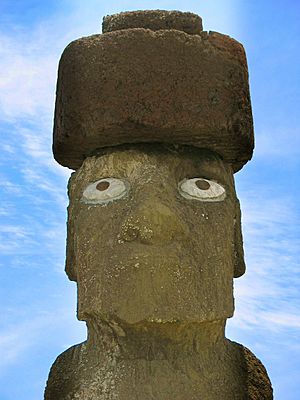Pukao facts for kids
Pukao are like big, hat-shaped stones that were placed on top of some of the famous moai statues on Easter Island. They look a bit like a bun or topknot of hair. These special stones were carved from a light-red volcanic rock called scoria. All of them came from one place: a quarry called Puna Pau.
Why Were Pukao Made?
Pukao were added to the moai statues later. This happened around the 15th and 16th centuries. We don't know for sure why they were made. But there are a few ideas.
One idea is that pukao showed how important someone was. Placing these huge stones on top of the moai was very hard. People back then did not have cranes or modern tools. So, it must have been a very special task.
Another idea is that pukao helped tell statues apart. Moai with pukao might have seemed more grand or important. They could have shown where special ceremonies should happen.
Today, many believe pukao represent hair. It was a custom for important men on Easter Island to wear their long hair in a bun on top of their heads.
How Pukao Were Built
Pukao are shaped like a cylinder. They have a dip on the bottom to fit onto the moai's head. On top, they often have a knob or knot. They were placed so they stuck out a bit in front.
Their size changed depending on the moai they were on. They could be from 6 to 10 feet (1.8 to 3 meters) wide. Some pukao weighed up to 11 short tons (10 metric tons). Adding a pukao made the statues taller, reaching about 37 feet (11 meters) on average.
The pukao were separate pieces balanced on the moai's head. Experts think they were lifted using ramps. It might have only taken a few people to do this. Ring-shaped marks on the pukao's bottom edges support this idea. They suggest logs were used to roll the pukao up a ramp.
Scientists have even made models to show this was possible. The oblong shape of pukao would have made them easier to roll up. No single method is proven, but many ideas, like using pulleys, are also possible.
So far, about 100 pukao have been found by archaeologists. They are found at Ahu (stone platforms) where statues have fallen. They are also found at the quarry where they were made.
Where Pukao Came From
The red topknots were made from a reddish volcanic rock called scoria. This rock came from a quarry called Puna Pau. This quarry was inside the crater of a volcano with the same name.
After the pukao were carved, they were rolled. People rolled them by hand or on tree logs. They followed an old road to the statue sites. This road was made of packed red scoria dust.
More than 70 discarded pukao have been found. They were found along the road and on raised ceremonial platforms. The indents found on the bottom of pukao that reached the statues are not on those found along the path. This suggests that basic carving was done at Puna Pau. The stone was shaped into a cylinder for easier transport. More detailed carvings were likely done at the moai site. This happened just before the pukao were placed on the statues.
See also
 In Spanish: Pukao para niños
In Spanish: Pukao para niños



